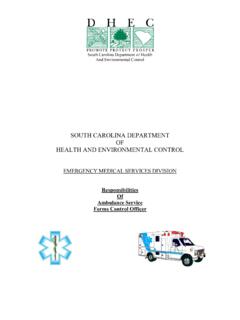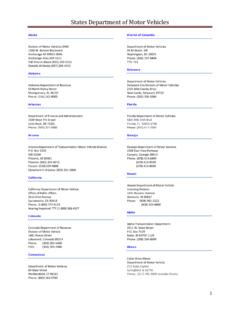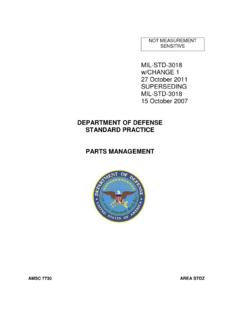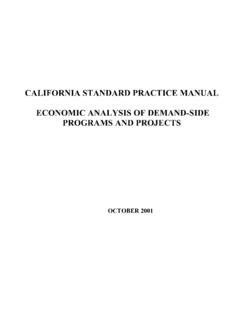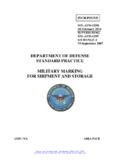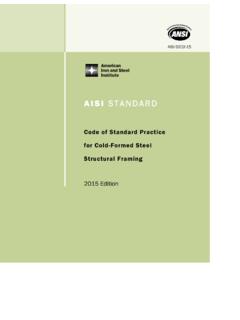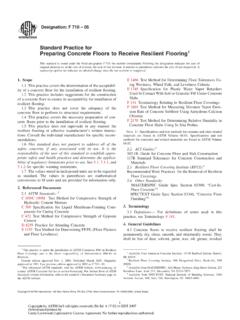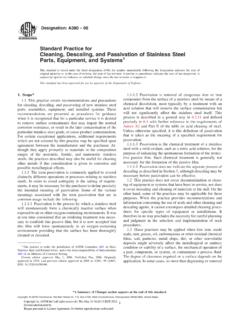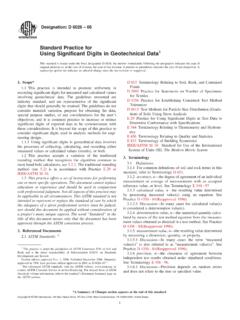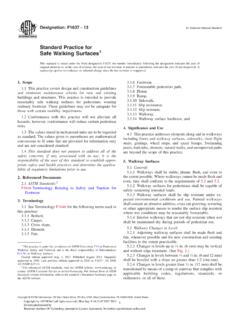Transcription of Standard Practice for Emergency Medical Dispatch ... - NHTSA
1 Appendix G 1a: Elements of an Emergency Medical Dispatch System Annual Book of ASTM standards , 1994 American Society for Testing and Materials (ASTM) Standard Practice for Emergency Medical Dispatch Management (1) Introduction The Emergency Medical dispatcher (EMD) is the principle link between the public caller requesting Emergency Medical assistance and the Emergency Medical service (EMS) resource delivery system. As such, the EMD plays a fundamental role in the ability of the EMS system to respond to a perceived Medical Emergency . With proper training, program administration, supervision, and Medical direction, the EMD can accurately query the caller, select an appropriate method of response, provide pertinent information to responders and give appropriate aid and direction for patients through the caller.
2 Through careful application and reference to a written, medically approved, Emergency Medical Dispatch protocol, sound decisions concerning EMS responses can be made in a safe, reproducible, and non-arbitrary manner. These benefits are realized by EMS systems when appropriate implementation, sound Medical management and quality assurance/quality improvement (QA/QI) at Dispatch are provided within the EMD/EMS system. This Practice assists in establishing these management and administrative standards . 1. Scope 1. This Practice covers the function of the Emergency Medical Dispatch (EMD).
3 This function is the prompt and accurate processing of calls for Emergency Medical assistance. The training and Practice through the use of a written or automated Medical Dispatch protocol is not sufficient in itself to ensure continued medically correct functioning of the EMD. Their Dispatch -specific Medical training and focal role in EMS has developed to such a complexity that only through a correctly structured and appropriately managed quality assurance environment can the benefits of their Practice be fully realized. The philosophies of Emergency Medical Dispatch have established new duties to which the Emergency Medical Dispatch agency must respond.
4 It is important that their quality assurance/quality improvement (QA/QI) activities, including initial hiring, orientation, training and certification, continuing Dispatch education, recertification, and performance evaluation be given appropriate managerial attention to help ensure the ongoing safety in their performance of the EMD. This Practice establishes functional guidelines for these managerial, administrative and supervisory functions. 2. The scope of this Practice includes: 1. The entry level selection criteria for hiring Emergency Medical dispatchers; 61 2.
5 The orientation of new Emergency Medical dispatchers; 3. Development of QA/QI mechanisms, management strategies and organizational structures for use within a comprehensive Emergency Medical Dispatch system; 4. Performance evaluation as a component of a comprehensive and ongoing quality assurance and risk management program for an Emergency Medical Dispatch system; 5. Development and provision of continuing Dispatch education activities for the Emergency Medical dispatcher; 6. Requirements for initial certification and recertification of the Emergency Medical dispatcher; 7.
6 Provision for comparative analysis between different EMD program approached available to the EMS community that conform to established EMD Practice standards prior to implementation of an Emergency Medical Dispatch program; and 8. Guidelines for implementation of an Emergency Medical Dispatch program. 1. This Standard does not purport to address all of the safety concerns, if any, associated with its use. It is the responsibility of the user of this Standard to establish appropriate safety and health practices and determine the applicability or regulatory limitations prior to use.
7 2. Referenced Documents 1. ASTM standards : F 1258 Practice for Emergency Medical Dispatch (2) F 1552 Practice for Training, Instructor Qualification, and Certification Eligibility of Emergency Medical Dispatchers (2) 3. Terminology 1. Descriptions of Terms Specific to This Standard : 1. case review template-a structured performance evaluation document containing all necessary input and output actions required of dispatchers that parallels the EMDs' on-line protocols, policies, and procedures related to call-taking and processing. It contains check-off lists and compliance scoring mechanisms that objectively rate the EMDs' performance on a single call.
8 2. Dispatch life support-the knowledge, procedures, and skills used by trained EMDs in providing care through pre-arrival instructions to callers. It consists of those BLS and ALS principles that are appropriate to application by Medical dispatchers. 3. Emergency Medical Dispatch agency-any organization or a combination of organizations working cooperatively, that routinely accepts calls for Emergency Medical assistance and facilitates the Dispatch of prehospital Emergency Medical resources/personnel and provides medically oriented pre-arrival instructions pursuant to such requests.
9 4. performance evaluation-the documented, objective, quantitative measure of an individual Emergency Medical dispatcher's performance based upon compliance to departmental protocols, policies and procedures. 62 5. pre-arrival instructions-telephone-rendered, medically approved written instructions provided by trained EMDs through callers which help to provide aid to the victim and control of the situation prior to arrival of prehospital personnel. 6. quality assurance/quality improvement (QA/QI)-the comprehensive program of prospectively setting standards ; concurrently monitoring the performance of clinical, operational and personnel components; and, retrospectively improving these components in the Emergency Medical Dispatch agency when compared with these standards .
10 7. risk management-a sub-component of the quality assurance program designed to identify problematic situations and to assist EMS Medical directors, Dispatch supervisors, and EMDs in modifying Practice behaviors found to be deficient by quality assessment procedures; to protect the public against incompetent practitioners; and to modify structural, resource, and protocol deficiencies that may exist in the Emergency Medical Dispatch system. 4. Summary of Practice 1. A comprehensive plan for managing the quality of care in an Emergency Medical Dispatch system must include careful planning, EMD program selection, proper system implementation, employee selection, training, certification, QA/QI, performance evaluation, continuing Dispatch education, recertification, and risk management activities.





